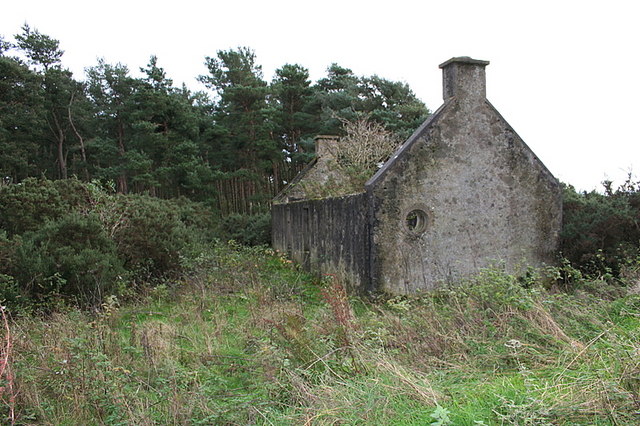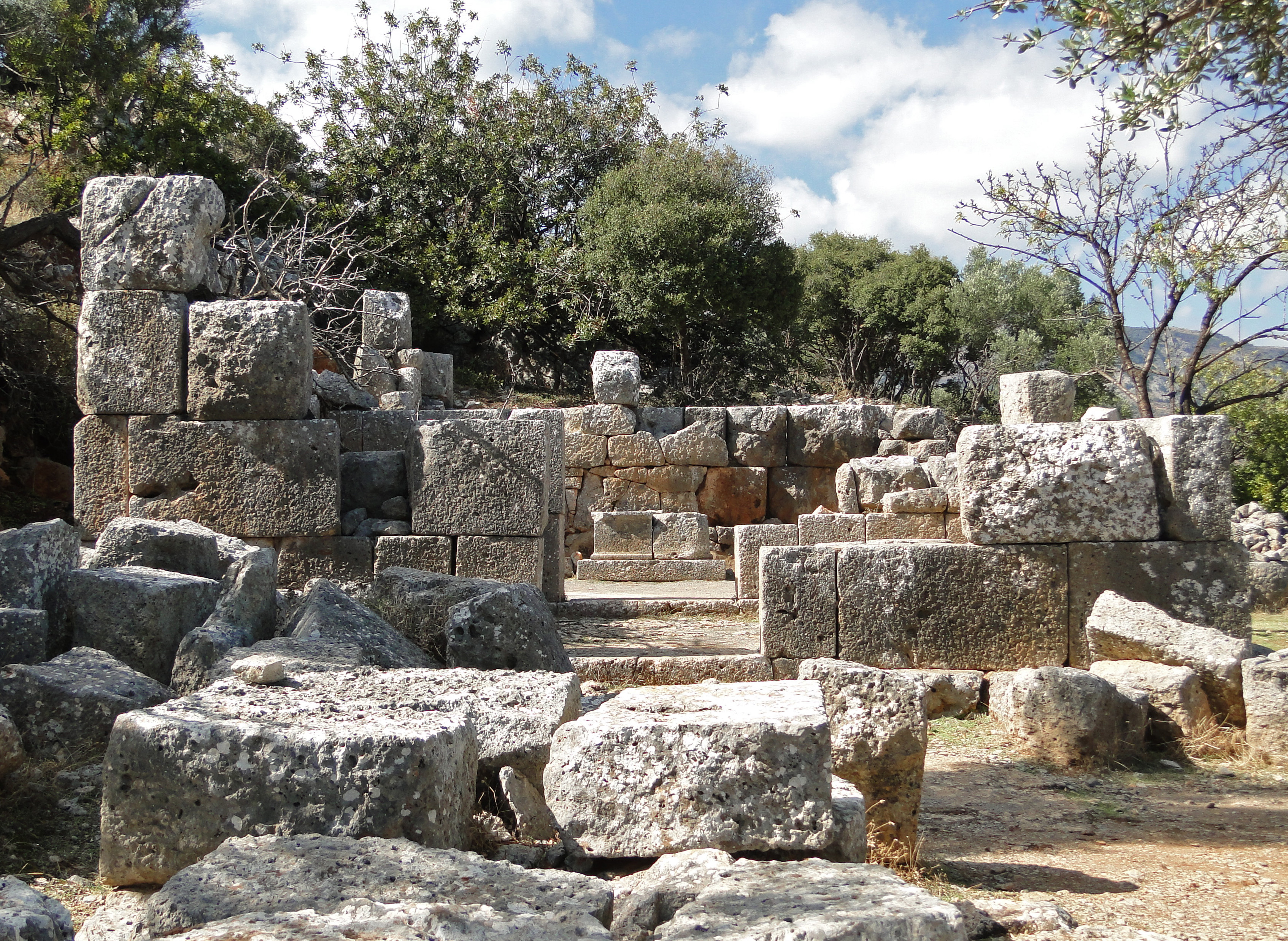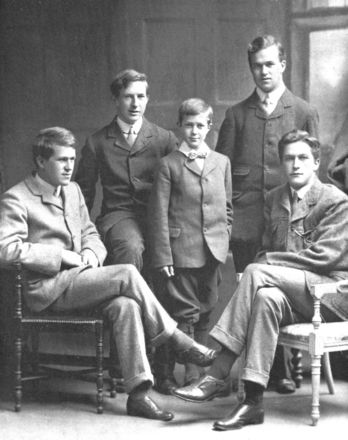|
Magasa, Crete
Magasa ( el, Μαγκασά) is a Neolithic settlement on the eastern part of the island of Crete in present-day Greece. Magasa is notable as a Neolithic Cretan settlement for some use of large room sizes in its multi-roomed residences. The ben-and-but style of housing design with some use of mud-dried brick has been noted as similar to that found in Neolithic Knossos.C.M.Hogan, 2007 See also *Lato *Kydonia Kydonia or Cydonia (; grc, Κυδωνία; lat, Cydonia) was an ancient city-state on the northwest coast of the island of Crete. It is at the site of the modern-day Greek city of Chania. In legend Cydonia was founded by King Cydon (), a son ... References Sources * British School at Athens, British School at Athens Managing Committee (1894) ''The Annual of the British School at Athens'', Macmillan Publishers * C. Michael Hogan''Knossos fieldnotes'', Modern Antiquarian (2007)* Arnold Walter Lawrence and Richard Allan Tomlinson (1996) ''Greek Architecture'', Yale U ... [...More Info...] [...Related Items...] OR: [Wikipedia] [Google] [Baidu] |
Neolithic
The Neolithic period, or New Stone Age, is an Old World archaeological period and the final division of the Stone Age. It saw the Neolithic Revolution, a wide-ranging set of developments that appear to have arisen independently in several parts of the world. This "Neolithic package" included the introduction of farming, domestication of animals, and change from a hunter-gatherer lifestyle to one of settlement. It began about 12,000 years ago when farming appeared in the Epipalaeolithic Near East, and later in other parts of the world. The Neolithic lasted in the Near East until the transitional period of the Chalcolithic (Copper Age) from about 6,500 years ago (4500 BC), marked by the development of metallurgy, leading up to the Bronze Age and Iron Age. In other places the Neolithic followed the Mesolithic (Middle Stone Age) and then lasted until later. In Ancient Egypt, the Neolithic lasted until the Protodynastic period, 3150 BC.Karin Sowada and Peter Grave. Egypt in th ... [...More Info...] [...Related Items...] OR: [Wikipedia] [Google] [Baidu] |
Human Settlement
In geography, statistics and archaeology, a settlement, locality or populated place is a community in which people live. The complexity of a settlement can range from a minuscule number of dwellings grouped together to the largest of cities with surrounding urbanized areas. Settlements may include hamlets, villages, towns and cities. A settlement may have known historical properties such as the date or era in which it was first settled, or first settled by particular people. In the field of geospatial predictive modeling, settlements are "a city, town, village or other agglomeration of buildings where people live and work". A settlement conventionally includes its constructed facilities such as roads, enclosures, field systems, boundary banks and ditches, ponds, parks and woods, wind and water mills, manor houses, moats and churches. History The earliest geographical evidence of a human settlement was Jebel Irhoud, where early modern human remains of ... [...More Info...] [...Related Items...] OR: [Wikipedia] [Google] [Baidu] |
Crete
Crete ( el, Κρήτη, translit=, Modern: , Ancient: ) is the largest and most populous of the Greek islands, the 88th largest island in the world and the fifth largest island in the Mediterranean Sea, after Sicily, Sardinia, Cyprus, and Corsica. Crete rests about south of the Greek mainland, and about southwest of Anatolia. Crete has an area of and a coastline of 1,046 km (650 mi). It bounds the southern border of the Aegean Sea, with the Sea of Crete (or North Cretan Sea) to the north and the Libyan Sea (or South Cretan Sea) to the south. Crete and a number of islands and islets that surround it constitute the Region of Crete ( el, Περιφέρεια Κρήτης, links=no), which is the southernmost of the 13 top-level administrative units of Greece, and the fifth most populous of Greece's regions. Its capital and largest city is Heraklion, on the north shore of the island. , the region had a population of 636,504. The Dodecanese are located to the no ... [...More Info...] [...Related Items...] OR: [Wikipedia] [Google] [Baidu] |
Greece
Greece,, or , romanized: ', officially the Hellenic Republic, is a country in Southeast Europe. It is situated on the southern tip of the Balkans, and is located at the crossroads of Europe, Asia, and Africa. Greece shares land borders with Albania to the northwest, North Macedonia and Bulgaria to the north, and Turkey to the northeast. The Aegean Sea lies to the east of the Geography of Greece, mainland, the Ionian Sea to the west, and the Sea of Crete and the Mediterranean Sea to the south. Greece has the longest coastline on the Mediterranean Basin, featuring List of islands of Greece, thousands of islands. The country consists of nine Geographic regions of Greece, traditional geographic regions, and has a population of approximately 10.4 million. Athens is the nation's capital and List of cities and towns in Greece, largest city, followed by Thessaloniki and Patras. Greece is considered the cradle of Western culture, Western civilization, being the birthplace of Athenian ... [...More Info...] [...Related Items...] OR: [Wikipedia] [Google] [Baidu] |
Ben-and-but
__NOTOC__ But and ben (or butt and ben) is an architectural style for a simple building, usually applied to a residence. The etymology is from the Scots term for a two-roomed cottage. The term describes a basic design of "outer room" conjoined with "inner room" as a residential building plan; the outer room, used as an antechamber or kitchen, is the ''but'', while the inner room is the ''ben''. The word ''but'', here, comes from Early Scots/Middle English "bouten" "outside", and ''ben'' from ES/ ME "binnen", "inside". See also * Blackhouse * Bothy * Cottage * ''The Broons ''The Broons'' (English: The Browns) is a comic strip in Scots published in the weekly Scottish newspaper ''The Sunday Post''. It features the Brown family, who live in a tenement flat at 10 Glebe Street in (since the late 1990s) the fictiona ...'' References * C. Michael Hogan''Knossos fieldnotes'', Modern Antiquarian (2007)* Ernest Ingersoll (1906) ''The Wit of the Wild'', Published by Dodd, Mead and ... [...More Info...] [...Related Items...] OR: [Wikipedia] [Google] [Baidu] |
Mudbrick
A mudbrick or mud-brick is an air-dried brick, made of a mixture of loam, mud, sand and water mixed with a binding material such as rice husks or straw. Mudbricks are known from 9000 BCE, though since 4000 BCE, bricks have also been fired, to increase their strength and durability. In warm regions with very little timber available to fuel a kiln, bricks were generally sun-dried. In some cases, brickmakers extended the life of mud bricks by putting fired bricks on top or covering them with stucco. Ancient world The history of mudbrick production and construction in the southern Levant may be dated as far back to the Pre-Pottery Neolithic A (e.g., PPNA Jericho). These sun dried mudbricks, also known as adobe or just mudbrick, were made from a mixture of sand, clay, water and frequently temper (e.g. chopped straw and chaff branches), and were the most common method/material for constructing earthen buildings throughout the ancient Near East for millennia. Unfired ... [...More Info...] [...Related Items...] OR: [Wikipedia] [Google] [Baidu] |
Knossos
Knossos (also Cnossos, both pronounced ; grc, Κνωσός, Knōsós, ; Linear B: ''Ko-no-so'') is the largest Bronze Age archaeological site on Crete and has been called Europe's oldest city. Settled as early as the Neolithic period, the name Knossos survives from ancient Greek references to the major city of Crete. The palace of Knossos eventually became the ceremonial and political centre of the Minoan civilization and culture. The palace was abandoned at some unknown time at the end of the Late Bronze Age, c. 1380–1100 BC; the reason is unknown, but one of the many disasters that befell the palace is generally put forward. In the First Palace Period (around 2000 BC), the urban area reached a size of as many as 18,000 people. Spelling The name Knossos was formerly latinization of names, Latinized as Cnossus or Cnossos and occasionally Knossus, Gnossus, or Gnossos but is now almost always written Knossos. Neolithic period The site of Knossos has had a very long history ... [...More Info...] [...Related Items...] OR: [Wikipedia] [Google] [Baidu] |
Lato
Lato ( grc, Λατώ, Latṓ) was an ancient city of Crete, the ruins of which are located approximately 3 km from the village of Kritsa. History The Dorian city-state was built in a defensible position overlooking Mirabello Bay between two peaks, both of which became acropolises to the city. Although the city probably predates the arrival of the Dorians, the ruins date mainly from the Dorian period (5th and 4th centuries BCE). The city was destroyed c. 200 BCE, but its port (Lato Etera or Lato pros Kamara), located near Agios Nikolaos was in use during Roman rule. This has led to the confusion, repeated by Stephanus of Byzantium quoting Xenion, a Cretan historian, that Kamara and Lato were one and the same. Modern scholarship distinguishes the two. The city most likely was named after the goddess Leto (of which Lato is the usual Doric form) and may be mentioned in Linear B tablets as RA-TO. [...More Info...] [...Related Items...] OR: [Wikipedia] [Google] [Baidu] |
Kydonia
Kydonia or Cydonia (; grc, Κυδωνία; lat, Cydonia) was an ancient city-state on the northwest coast of the island of Crete. It is at the site of the modern-day Greek city of Chania. In legend Cydonia was founded by King Cydon (), a son of Hermes or Apollo and of Akakallis, the daughter of King Minos. According to Pausanias he was son of king Tegeates. Diodorus Siculus mentions that the city was founded by King Minos. The editors of the ''Barrington Atlas of the Greek and Roman World'' suggest that the city also bore the name Apollonia ( grc, Ἀπολλωνία). Prehistoric period The name of the city is first mentioned in Linear B tablets from Knossos (ku-do-ni-ja). At Kastelli hill, which is the citadel of Chania's harbor, archaeological excavations have discovered ceramic sherds, which date back to Neolithic era. Scarce finds such as walls and ground floors confirm that the systematic habitation of the hill began during Early Minoan (EM) II period. A Minoan Ho ... [...More Info...] [...Related Items...] OR: [Wikipedia] [Google] [Baidu] |
Arnold Walter Lawrence
Arnold Walter Lawrence (2 May 1900 – 31 March 1991) was a British authority on classical sculpture and architecture. He was Laurence Professor of Classical Archaeology at Cambridge University in the 1940s, and in the early 1950s in Accra he founded what later became the Ghana Museums and Monuments Board as well as the National Museum of Ghana. He was the youngest brother of T. E. Lawrence ("Lawrence of Arabia") and his literary executor. Early life Arnold Lawrence was born at 2 Polstead Road, Oxford, on 2 May 1900, the youngest of five sons born to Thomas Chapman (who became, in 1914, Sir Thomas Chapman, 7th Baronet), an Anglo-Irish nobleman from County Westmeath, and Sarah Junner (1861–1959). The couple were unmarried but took the names "Thomas Robert Lawrence" and "Sarah Lawrence". Their second son was T. E. Lawrence who later found fame as "Lawrence of Arabia". He and Arnold Lawrence were close. The Lawrence children were brought up in Oxford by their mother who was v ... [...More Info...] [...Related Items...] OR: [Wikipedia] [Google] [Baidu] |
Neolithic Settlements In Crete
The Neolithic period, or New Stone Age, is an Old World archaeological period and the final division of the Stone Age. It saw the Neolithic Revolution, a wide-ranging set of developments that appear to have arisen independently in several parts of the world. This "Neolithic package" included the introduction of farming, domestication of animals, and change from a hunter-gatherer lifestyle to one of settlement. It began about 12,000 years ago when farming appeared in the Epipalaeolithic Near East, and later in other parts of the world. The Neolithic lasted in the Near East until the transitional period of the Chalcolithic (Copper Age) from about 6,500 years ago (4500 BC), marked by the development of metallurgy, leading up to the Bronze Age and Iron Age. In other places the Neolithic followed the Mesolithic (Middle Stone Age) and then lasted until later. In Ancient Egypt, the Neolithic lasted until the Protodynastic period, 3150 BC.Karin Sowada and Peter Grave. Egypt in the ... [...More Info...] [...Related Items...] OR: [Wikipedia] [Google] [Baidu] |







